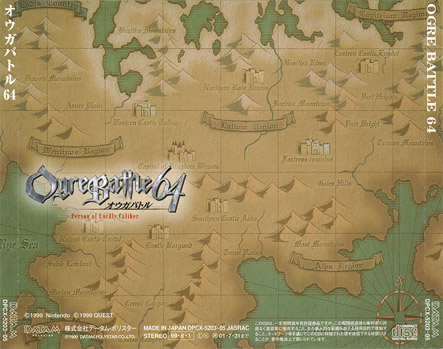Composers: Hayato Matsuo, Masaharu Iwata, and Hitoshi Sakamoto
When it came to playing Ogre Battle 64, I knew I had my work cut out for me on so many levels. I knew I wasn’t going to put myself through the task of playing the entire 50+ hour campaign while in the middle of my work, but I was on the lookout for particulars to latch onto. What moments and details could I take with me to cite to other folks, in addition to my own review? Thankfully, even though I took more than a few moments (and some outside help) to get my grasp on the battle system, there was more that struck me right away as both unique for the N64, and in the upper echelons of the library as a whole. The first bookmark I stuck into my experiences? “Fortune Teller II,” a track that shows up early and often in the game, including the character-building scene.
“Honestly, it wasn’t like I hadn’t heard it before. You don’t listen to as many “relaxing N64 music” compilations as I do without making a note when you hear something outside of “Dire, Dire Docks,” “Hang Glider,” or “DK Isle.” But that doesn’t make it any less beautiful in context. Maybe I would find it less special if I were more attuned to the genres that use such styles of music — JRPGs and the like, particularly on the SNES. Take any “Honestly, it wasn’t like I hadn’t heard it before. You don’t listen to as many “relaxing N64 music” compilations as I do without making a note when you hear something outside of “Dire, Dire Docks,” “Hang Glider,” or “DK Isle.” But that doesn’t make it any less beautiful in context. Maybe I would find it less special if I were more attuned to the genres that use such styles of music — JRPGs and the like, particularly on the SNES. Take any similar “relaxing” compilation for SNES music and you’ll get a lot of that. Including the original “Fortune Teller” track from the first Ogre Battle game — they’re not all that similar in composition, but boast a similar style.
Even with the limitations of the MIDI sound library, the three composers that made up the impressively full score of Ogre Battle 64: Person of Lordly Caliber did an excellent job. “Fortune Teller II” displays this with a remarkably “full” sound dynamic, and a lovely arrangement of melodies. The backing instrumentation opts for arpeggios rather than simply playing the tones, but the gentle plucking of the harp strings combined with the wind melodies combine to give the track the mystical feeling suggested by its name. A similar blend of timbre and melody to what makes tracks like “Shooting Star Summit” from Paper Mario and “Astral Observatory” from Majora’s Mask so otherworldly, but in a calming way, rather than an alienating one.
